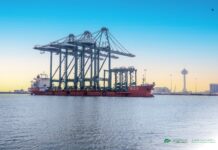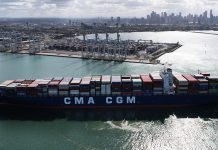
The Biden-Harris Administration and US Department of Transportation have announced the launch of a major supply chain initiative, Freight Logistics Optimization Works (FLOW), aiming to help speed up delivery times and reduce consumer costs.
FLOW is an information-sharing initiative to pilot key freight information exchange between parts of the goods movement supply chain, according to the US DoT.
“This nationwide supply chain data visibility effort will support system resiliency, improve our trade competitiveness and empower American businesses to get products to market with greater consistency and reduced cost,” commented Gene Seroka, executive director of Port of Los Angeles, which is one of the 18 initial participants of the initiative.
FLOW includes 18 participants who represent diverse perspectives across the supply chain, including private businesses, trucking, warehousing, logistics companies, ports, and more.
Port of Los Angeles, Port of Long Beach, Georgia Port Authority (GPA), MSC and Digital Container Shipping Association (DCSA) are among the initial participants of the initiative.
“We strongly believe that a common and interoperable digital infrastructure throughout the container shipping industry is a critical step to make supply chains more efficient, secure and resilient,” said André Simha, chief digital & information officer at MSC, and added, “there is no doubt that this initiative will strengthen the foundation for the seamless, end-to-end exchange of information we all need to keep global trade moving today and tomorrow.”
The US government hopes and expects more transportation and logistics stakeholders to participate in the initiative in the future.
The partners will work together with the Biden-Harris Administration to develop an information exchange to ease supply chain congestion, speed up the movement of goods, and ultimately cut costs for consumers.
“Developing common data standards to facilitate freight movement is an important part of truly bringing our industry into the 21st century,” pointed out Mario Cordero, Port of Long Beach executive director.
Griff Lynch, GPA executive director, stated, “Greater transparency — knowing where a vessel or a container is at every stage of transit — would provide the predictability cargo owners and logistics providers need to optimize the use of resources. Through better communication, aspects of the supply chain such as timing on production, staffing, trucks and chassis, and warehouse space can be fine-tuned for greater efficiency and velocity.”
In a similar direction, Thomas Bagge, CEO of DCSA, believes that “having an interoperable digital infrastructure will help eliminate blind spots by increasing the availability and reliability of data.”





